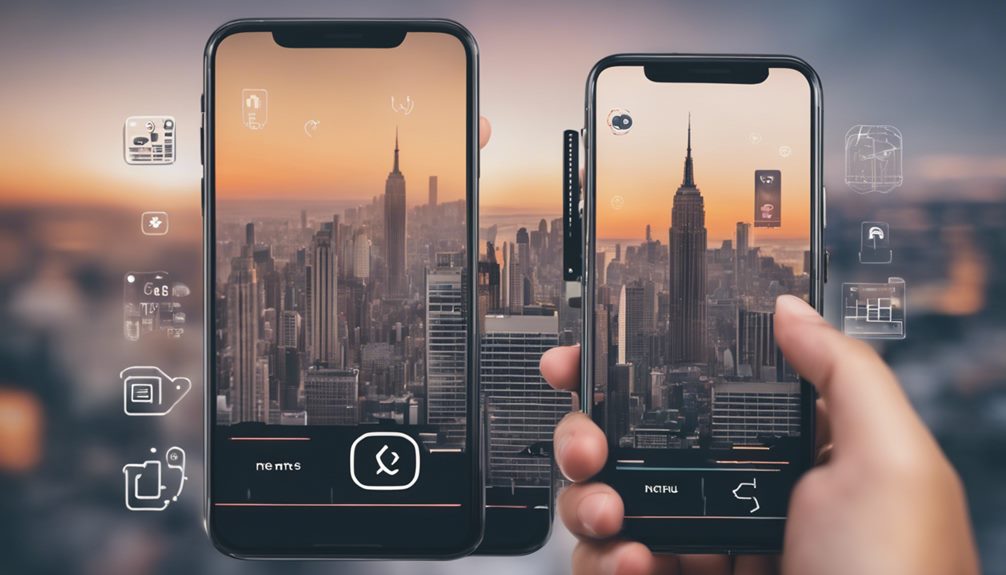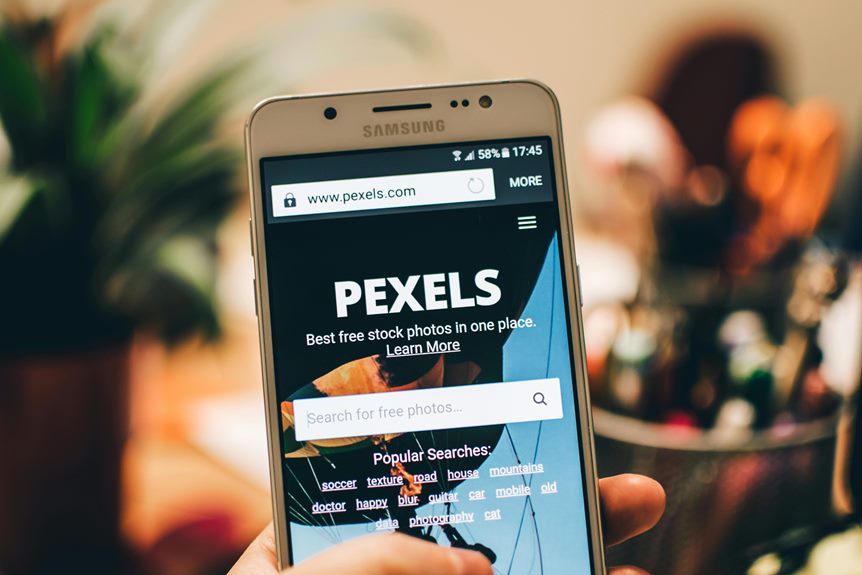You've probably noticed how essential mobile usability is for SEO success, but have you considered the intricacies involved in optimizing your site for mobile users? It's not just about having a responsive design; it's about creating a seamless experience that encourages engagement. Factors like page load speed, intuitive navigation, and touch-friendly elements play a significant role in how users interact with your site. By focusing on these aspects, you can significantly enhance user satisfaction and, in turn, improve your search engine rankings. So, what's the next step in ensuring your mobile site is not just accessible, but exceptional?
Prioritize Mobile-First Design
In the realm of digital strategy, it's essential to prioritize mobile-first design for optimal SEO results. By implementing a mobile-first approach, you ensure your website caters primarily to mobile users, which is crucial given the increasing mobile internet usage.
Google's indexing practices now prioritize mobile versions of sites, making it imperative for your design to be responsive and user-friendly on smaller screens.
Strategically, focus on a clean and intuitive interface that emphasizes essential content and functionality. Use a responsive web design (RWD) framework, enabling your site to adapt seamlessly across various devices. This enhances user experience, reducing bounce rates, and improving dwell time—critical factors that Google considers in its ranking algorithms.
Analyzing user behavior is key. Tools like Google Analytics can provide insights into how mobile users interact with your site. This data helps you identify pain points and areas for improvement, allowing you to refine your design continuously.
Prioritize content hierarchy by placing critical information at the top, ensuring accessibility. Don't overlook touch-friendly navigation; larger buttons and easy-to-read fonts enhance usability.
Optimize Page Load Speed
To boost your website's SEO performance, optimizing page load speed is essential. In today's fast-paced digital environment, users expect instant gratification, and search engines prioritize speedy sites. You need to focus on strategies that enhance load times, ensuring your mobile site delivers content efficiently.
Start by analyzing your current page speed using tools like Google PageSpeed Insights. This will help you identify specific areas for improvement. Here are four technical strategies to implement:
- Compress Images: Optimize images by reducing their file size without sacrificing quality. Use formats like WebP and tools like TinyPNG to achieve this.
- Leverage Browser Caching: Enable browser caching to store static resources on users' devices. This reduces the need to reload the entire page on subsequent visits, significantly improving load speed.
- Minify CSS, JavaScript, and HTML: Remove unnecessary characters, spaces, and comments in your site's code. Tools like UglifyJS and CSSNano can automate this process, making your codebase leaner and faster.
- Use a Content Delivery Network (CDN): Distribute your content across multiple servers worldwide. A CDN decreases the distance between your server and users, reducing latency and speeding up load times.
Implementing these changes strategically will improve user experience and drive SEO success.
Simplify Navigation Menus

A well-structured navigation menu plays a pivotal role in enhancing mobile site usability and boosting SEO. You must ensure that users can find what they're looking for quickly and efficiently. Start by limiting the number of menu items; too many options can overwhelm users and reduce site performance.
Prioritize essential links by placing them first, making them easily accessible. Employ a hierarchical structure to group related items under broad categories, which helps users and search engines understand your site's architecture better.
Implement a responsive design, ensuring the menu adapts seamlessly to various screen sizes, enhancing the user experience. Use clear, concise labels for each menu item, avoiding industry jargon. This not only aids user comprehension but also aligns with SEO best practices by helping search engines index your pages accurately.
Consider a collapsible menu or hamburger icon to conserve screen space without sacrificing functionality.
Test your navigation menu across different devices and browsers to identify potential usability issues. Utilize analytics tools to track user interactions, assessing the effectiveness of your menu design.
Enhance Touchscreen Interactions
Simplifying navigation menus lays a solid foundation, yet optimizing touchscreen interactions takes mobile site usability to the next level.
When users interact with your site, they expect seamless and responsive touch controls. Here's how you can enhance touchscreen interactions strategically:
- Touch Targets: Ensure buttons and links are large enough for users to tap easily without zooming. Aim for a minimum size of 44×44 pixels, as recommended by Apple's Human Interface Guidelines.
- Gestures: Implement intuitive gestures that users are familiar with, like swiping and pinching. These gestures should be consistent across your site to avoid confusion and enhance the user experience.
- Feedback: Provide immediate visual or haptic feedback for touch interactions. Users should know their actions have been registered. For instance, buttons can change color or slightly animate when tapped.
- Swipe Navigation: Consider including swipe-based navigation for transitioning between pages or content sections. This can make browsing quicker and more engaging, especially for content-heavy sites.
Implement Responsive Images

To enhance mobile site usability and SEO, you should focus on implementing responsive images by optimizing image loading speed, using adaptive image formats, and applying CSS media queries.
By optimizing image loading speed, you can reduce page load times, improving user experience and search engine rankings.
Adaptive image formats and CSS media queries allow images to scale appropriately across devices, ensuring that your mobile site remains visually appealing and efficient.
Optimize Image Loading Speed
With the rapid evolution of mobile technology, ensuring your images load efficiently has become a critical component of optimizing your website's mobile usability for better SEO.
Slow-loading images can frustrate users, increase bounce rates, and ultimately harm your search rankings. By implementing responsive images, you can strategically enhance loading speeds and improve user experience.
Here's how you can optimize image loading speed:
- Use Correct Image Dimensions: Ensure images are dynamically resized to fit the viewport. This reduces unnecessary data transfer and speeds up loading times. Use HTML attributes like 'srcset' and 'sizes' to serve different image sizes based on the device.
- Enable Lazy Loading: Implement lazy loading to defer off-screen images until a user scrolls near them. This reduces initial load time, making your site faster and responsive to user interactions.
- Compress Images Appropriately: Use image compression techniques to reduce file size without compromising quality. Tools like TinyPNG or ImageOptim can help maintain balance between size and visual fidelity.
- Leverage Browser Caching: Configure your server to store images in users' cache, reducing load times on repeat visits. Set appropriate cache expiration periods using HTTP headers.
Use Adaptive Image Formats
Adopting adaptive image formats is a strategic move to enhance mobile site usability and boost SEO performance. These formats, such as WebP and AVIF, provide superior compression and quality compared to traditional JPEGs and PNGs. By using these, you can reduce image file sizes significantly without compromising visual quality, leading to faster loading times on mobile devices.
Faster loading times directly contribute to better user experience, reducing bounce rates and ultimately improving your search engine rankings.
To implement adaptive images effectively, you should use the '
Additionally, always specify image dimensions to prevent layout shifts, which can disrupt user interaction and affect SEO negatively.
Incorporating responsive images involves not only choosing the right formats but also optimizing for different screen sizes. Use the 'srcset' attribute to define multiple image sources, enabling browsers to select the most appropriate one based on the device's screen resolution and size, ensuring optimal performance and visual appeal.
Implement CSS Media Queries
Harnessing the power of CSS media queries is crucial for creating a responsive mobile site that enhances user experience and boosts SEO performance. By adapting your design according to various screen sizes and resolutions, you ensure that your content remains accessible and visually appealing on any device.
CSS media queries allow you to define specific styles for different device characteristics, such as width, height, or orientation. Implementing these queries strategically can lead to a significant improvement in your mobile site's usability and search engine ranking.
To effectively implement CSS media queries, consider the following steps:
- Identify Breakpoints: Determine the key screen sizes where layout changes are necessary. Common breakpoints include 320px, 768px, and 1024px, but you should analyze your site's traffic to find the most relevant ones.
- Prioritize Content: Decide which elements are essential for mobile users and ensure they're prominently displayed. This prioritization helps in creating a mobile-first design approach.
- Test Responsiveness: Use browser developer tools to simulate different devices and screen sizes. Testing ensures that media queries are functioning as intended.
- Optimize Performance: Minimize CSS file size by only including necessary styles within media queries to enhance loading speed and reduce resource consumption.
Use Readable Font Sizes
You should ensure that font sizes on your mobile site enhance text visibility to improve user engagement and reduce bounce rates.
Prioritizing user accessibility by using scalable fonts allows content to be easily readable across different devices and screen sizes.
Strategically optimizing font scaling not only benefits the user experience but also contributes positively to your SEO performance by meeting search engine guidelines.
Enhance Text Visibility
A crucial element in mobile site usability is ensuring text visibility through the use of readable font sizes.
Text that's too small can frustrate users and lead to higher bounce rates, negatively impacting your SEO.
Strategically selecting the right font size enhances user experience, making your content more accessible and engaging.
Here's how you can enhance text visibility effectively:
- Set a Minimum Font Size: Stick to a minimum font size of 16 pixels for body text. This ensures readability without requiring users to zoom in. Remember, clarity is key.
- Prioritize Line Height and Spacing: Use a line height of at least 1.5 times the font size. Adequate spacing between lines increases readability and reduces eye strain, especially on smaller screens.
- Utilize Responsive Typography: Implement media queries to adjust font sizes for different devices. This adaptability ensures text remains readable across all screen sizes, enhancing user satisfaction.
- Contrast and Color: Ensure sufficient contrast between text and background colors. High contrast improves visibility, making your content accessible in various lighting conditions.
Prioritize User Accessibility
Prioritizing user accessibility on your mobile site is a strategic move that can significantly boost its usability and SEO performance. One critical aspect is ensuring your font sizes are readable across various devices. Small, cramped text can frustrate users, increasing bounce rates and negatively impacting engagement metrics—key factors search engines consider for ranking. By setting a minimum font size of at least 16px, you ensure readability without requiring users to zoom, which enhances their experience and retention.
Analyze your audience's needs by considering their demographics and device usage patterns. Older audiences might require larger fonts, while younger users may prefer smaller, more compact layouts. Implementing responsive typography fundamentally aligns with accessibility standards and boosts your site's credibility.
Additionally, consider line height and letter spacing to further enhance text clarity. Emphasize contrast between text and background to improve legibility, especially for users with visual impairments. Use tools like color contrast analyzers to ensure compliance with accessibility guidelines.
Optimize Font Scaling
Craftsmanship in font scaling can transform your mobile site into a more engaging and accessible platform.
When fonts are too small, users struggle to read your content, leading to a frustrating experience that increases bounce rates.
To optimize font scaling strategically, consider these key factors:
- Minimum Readable Size: Ensure your font size is at least 16 pixels. This is a widely accepted baseline that suits most users, reducing the need for pinching and zooming.
- Responsive Typography: Implement fluid typography that adjusts font size based on screen dimensions. Use CSS media queries and relative units like "em" or "rem" to make text scalable across various devices.
- Line Height and Spacing: Maintain a line height of 1.5 times the font size to enhance readability. Adequate spacing prevents text from appearing cramped, improving user experience and comprehension.
- Contrast and Color: High contrast between text and background is crucial. Choose colors that make your text stand out, ensuring accessibility for users with visual impairments.
Conclusion
Think of your mobile site as the engine of a high-performance car. By prioritizing mobile-first design, optimizing page load speed, and simplifying navigation, you're fine-tuning that engine for peak efficiency. Enhancing touchscreen interactions and using responsive images ensures a smooth ride, while readable font sizes keep the dashboard clear and accessible. Regularly analyze user behavior to keep your engine running smoothly. This strategic approach will steer you toward higher traffic and improved search rankings.


